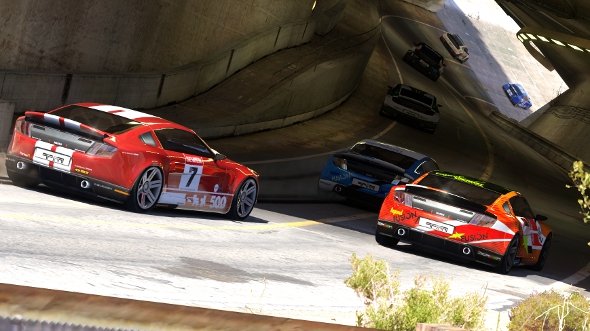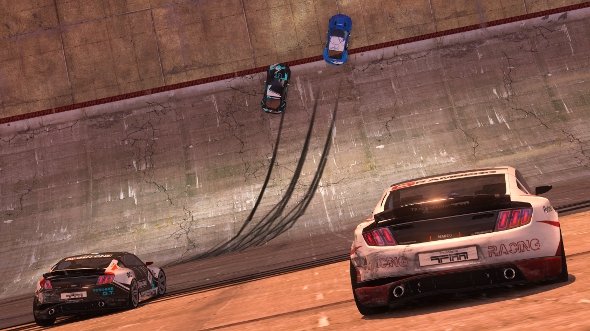
Bedroom coders' lairs aside, Nadeo must be the smallest studio you could ever hope to visit. It's so small that the guidance on how to get there counts the precise number of steps to descend before you reach the front door (it's four). You park your coat in the mezzanine, nod to the receptionist on your way into the main office, then realise that the mezzanine is the main office, that the 'receptionist' is actually studio founder Florent Castelnérac and that you were dangerously close to walking into a cupboard.
Unless you're Douglas Adams, this isn't what you expect the centre of a universe to look like.
Nadeo might be small, but TrackMania, the virtual Scalextric game they've been building since 2003, is made in a studio of almost cosmic proportions. They have millions of offices scattered around the globe, linked to the same servers, running the same code.
The players build its content: hundreds of cars and over 150,000 tracks. They do its PR: screenshots, trailers, fan sites and movies. They manage and spend its currency, building banks, casinos, tournaments and shops. They decide what modes to add and what avenues to explore. They are the players and makers of a game that knows no distinction.
Being enormously French, Castelnérac has 100 different ways of putting this. TrackMania is “like a piano”, he declares, “which we deliver to the community so they can create blues, rock and roll and classical music. They share and they listen.” It's also “a creation tool like Photoshop or Visual Studio.” As well as being “the YouTube of games”, “the temple of creation”, and “an invitation to an adventure”.
If you think he's describing anything and everything, you're starting to get the idea. Because we're not just talking about TrackMania anymore; that was the last adventure, says Castelnérac, for the last decade. We're not even talking about TrackMania 2: Canyon, the remarkably straightforward sequel that strips everything back to basics, reverting to a single race gametype and the rocky terrain set of the very first instalment. What we're talking about is something incredible: ManiaPlanet, incorporating TM2, ShootMania (a first-person shooter) and QuestMania (a roleplaying game).
It's not the enormity, but the simplicity of the thing that makes your head spin. Arriving in a neat sequence – TM2 is basically finished, ShootMania is currently under heavy development and QuestMania is still at the blue sky stage – all of these incorporate the same block-based editing suite as the previous TrackMania games. As well as having fun playing, you'll build your own shooters or RPGS – including the levels, guns and enemies.
Keep up to date with the most important stories and the best deals, as picked by the PC Gamer team.

Furthermore, “under each title you have the same game operating system, which is running them all together”, notes Castelnérac. “All the files, tools, formats and things for the community are shared.”
So, when you log on to ManiaPlanet, the first thing to appear is a carousel of games, each of which loads instantly because the bulk of the loading is already done. And for the first few months of release (some time in the second half of this year), the one you're guaranteed is TM2: Canyon, the toy racer of the Noughties that has most definitely grown up.
“I thought we'd have the [handling] model within a day, just like the first TrackMania,” smiles Castelnérac, “but it was a fight. It took a year for TrackMania 2. The space for that feeling is really wide: you've got the crazy area and the realistic area, and we have to be somewhere in the middle. But even just a month ago I was still tweaking the parameters.
What he and his 15-man studio have achieved in that time is all kinds of wonderful. That handling now sits perfectly between the heavyweight world of a triple-A racer and the flyweights of old, binding intimidating power and momentum to that four-key control scheme. There's damage – “simply because it's important that players can make and smash the cars” – and a sense that it's deserved. And there's a playful violence to the way that the cars interpret those inputs, a switch from accelerate (up arrow) to brake (down arrow) making lurch onto front axle and angrily reverse. They're still toys, impervious to all but cosmetic harm, but now they're the kind sold in hobby stores next to the gas-powered Kalashnikovs.
Then there's the lighting, which, thanks to radiosity, simply gets everything right. The maps, some made by the TM community's elite, actually look like vast vandalised canyons where routes have been carved and bored into mountains. Sun and shadow play on them accordingly, threatening whiteout as you exit dark tunnels. The reflections on the hurtling carbon fibre are the stuff that great screenshots are made of – and you'll be making them, with a replay editor that smooths, processes and beautifies on demand.
And that, believe it or not, is about it. Castelnérac explains: “We want to make it pure, and sometimes we have to show new features because there's nothing else. So be warned: there are no new features in this TrackMania, except damage. We don't care about new modes: the player can create those. As a gamer, I want to buy a racing game, a fun challenge that's as pure and good as possible. It'll be the same with ShootMania. In TrackMania there's one car, no tuning, no AI, no collision; ShootMania won't have experience points, 40 levels and 12 classes, etc.”
Those industrious TrackManiacs might later make him a liar, but he's right for now: in vanilla form, his FPS construction kit is almost impossibly basic, but in a good way. There's no gun model, and the bullets are just little puffs of energy flung from the camera. The character models are still being worked on, but don't expect a regular infantry.

“We want this spectator-friendly, e-sport-friendly and competition friendly,” says Castelnérac. “Because today, Counter-Strike is ten years old. I won't say they have problems, but there are obvious elements to consider in games now – showing terrorism and counter-terrorism, shooting people and so forth. For sponsors and TV broadcasts, these things are damaging the good spirit of sport. So we're trying to bring out a game that's compatible with this environment.”
Watching him cycle through the maps he's been toying with, you realise very quickly how much baggage the FPS has carried over the years, and what wonders can be achieved by just shrugging it all off. There's no hardware in ShootMania, no stupid pretexts to killing, no fan service and no gadgets. What you get instead are the building blocks (smaller than TrackMania's, to suit the genre and its environments) of the FPS itself: the stuff of maps and modes.
First out of the forge, introduced with a chuckle, is The Butcher Place – a CTF map in which the teams' bases are just eight metres apart, meaning utter carnage when someone returns with the flag. Trapped Up is a kind of tower defence map in which the defenders respawn more slowly with time, ensuring an eventual win for their enemy. Another map guarantees “a massacre” as players rush along a precarious ledge towards respawn checkpoints, while under constant pulverising fire from central gun emplacements. Castelnérac builds another basic map (including flags, terrain, routes, spawn points and so on) in just a couple of minutes.
“The question is: can I express myself and make something fun?” he says, as he flicks instantly between content browser, editor and realtime play. If these maps turn out to be utter pap, or as enduring as a job at Activision, then it doesn't matter; all they have to be is fun, witty, charming, comically bad, inventive, disastrously overambitious, gleefully offensive... Whatever you'd expect of a five minute trip to YouTube. Nadeo have built more than 100 maps so far. Would anyone like to bet against there being over 100,000 before the decade's done? No, didn't think so.
This really is just the tip of the iceberg. Nadeo's vision for e-sports requires there to be maps made of competition quality, and the phenomenal success of TrackMania in that regard suggests nothing less will do. But get this: because every ManiaPlanet title is as modular as the other, there's little to stop the most ingenious of players from building, say, AI behaviours, singleplayer components, scenery prefabs, weapon types, characters, scripts, rule sets or even interactive tutorials, and selling them all (virtually, of course) on the ManiaPlanet marketplace.

Moreover, thanks to Castelnérac's newfound obsession with the history of id Software, the whole ManiaPlanet suite now has a pack editor. So, if someone makes an FPS about woodwind instruments owning the brass section, in maps that imagine MC Escher's take on the movies of Steven Seagal, everything that entails can be safely bundled (thank God) into a single download. One click downloads and installs it as a separate title on the ShootMania front-end, and ensures that none of its changes affect the rest of your experience. Its leaderboards and game browser will be unique on the ManiaPlanet servers.
This isn't modding, and it's too organic to be fairly branded as usergenerated content. Like TrackMania before it, ShootMania promises to be nothing short of primordial FPS soup. When you consider that what started as a game about time trials in silly cars has spawned action movies, singleplayer RPGs, casino games, TV adverts and a world of supporting websites and services, none of them created by Nadeo, the potential speaks for itself.
And QuestMania? Top secret for now. We know it's partly inspired by John Carmack's ideas, an adventure based on a dedicated server and connected community. It's about “events, progress and consequences”, teases Castelnérac. It's not Oblivion, because that's “a story well told by a single author”, far too simple a concept to compare. So it's more like Dungeons & Dragons, then: pen, paper and imagination... And maybe some Lego and techno.
PC Gamer is the global authority on PC games—starting in 1993 with the magazine, and then in 2010 with this website you're currently reading. We have writers across the US, Canada, UK and Australia, who you can read about here.


